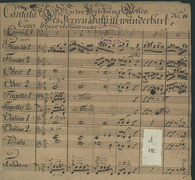Christian Gotthilf Tag @ RISM
Martina Falletta
Tuesday, August 2, 2011

Christian Gotthilf Tag (2 April 1735 – 19 July 1811) was a notable German cantor, organist, and composer of the 18th century. Although his influence was only felt in Saxony, a variety of copies and commissions from Hamburg, Berlin, and Danzig have lead to his works being preserved today throughout Germany, Poland, Denmark, and the United States (see the records in the RISM online catalog).
Tag was educated at the Kreuzschule in Dresden and in 1755 took on the vacant post of cantor and schoolteacher in nearby Hohenstein, which he held until 1808. Throughout his life, he remained in regular contact with the leading musicians of his time and maintained amicable relationships with his teacher Gottfried August Homilius, Johann Adam Hiller, and the scholar Carl Heinrich Ludwig Pölitz. Among his pupils was Christian Gottlob Neffe, who was later Ludwig van Beethoven’s composition teacher. Tag thus can be placed exactly between Bach and Beethoven in the genealogy of teachers and students (Bach – Homilius – Tag – Neefe – Beethoven).
Over 180 cantatas are at the center of Tag’s oeuvre. These compositions, mostly based on Pietist texts, reveal the influence of the Dresden composers Johann Adolf Hasse and his colleague Johann Gottlieb Naumann. Masses, motets, hymns, lieder, and choral preludes for organ and winds are also part of his creative output. Many of his 90 lieder either found their way into contemporary collections (for example, Johann Adam Hiller’s Wöchentliche Nachrichten) or were published individually (see RISM A/I: T 13-27).
On July 19, a concert in the Saxon town of Lugau paid tribute to the 200th anniversary of Hiller’s death by performing his cantata Gott, wie dein Name as well as the Bergfestkantate. The cantatas that were recently rediscovered in the holdings of the Church of St. Bartholomew in Blankenburg, Germany (D-BLAbk, today in the regional church archives in Wolfenbüttel) present a rich opportunity to tap into the works of Tag. Editions and recordings have been only sparse (a small offering can be found at www.konsid-musik.de/KM090.html)). Here, particularly with the cantatas, many possibilities are still open to make the composer known (again).
Share Tweet EmailCategory: New at RISM

